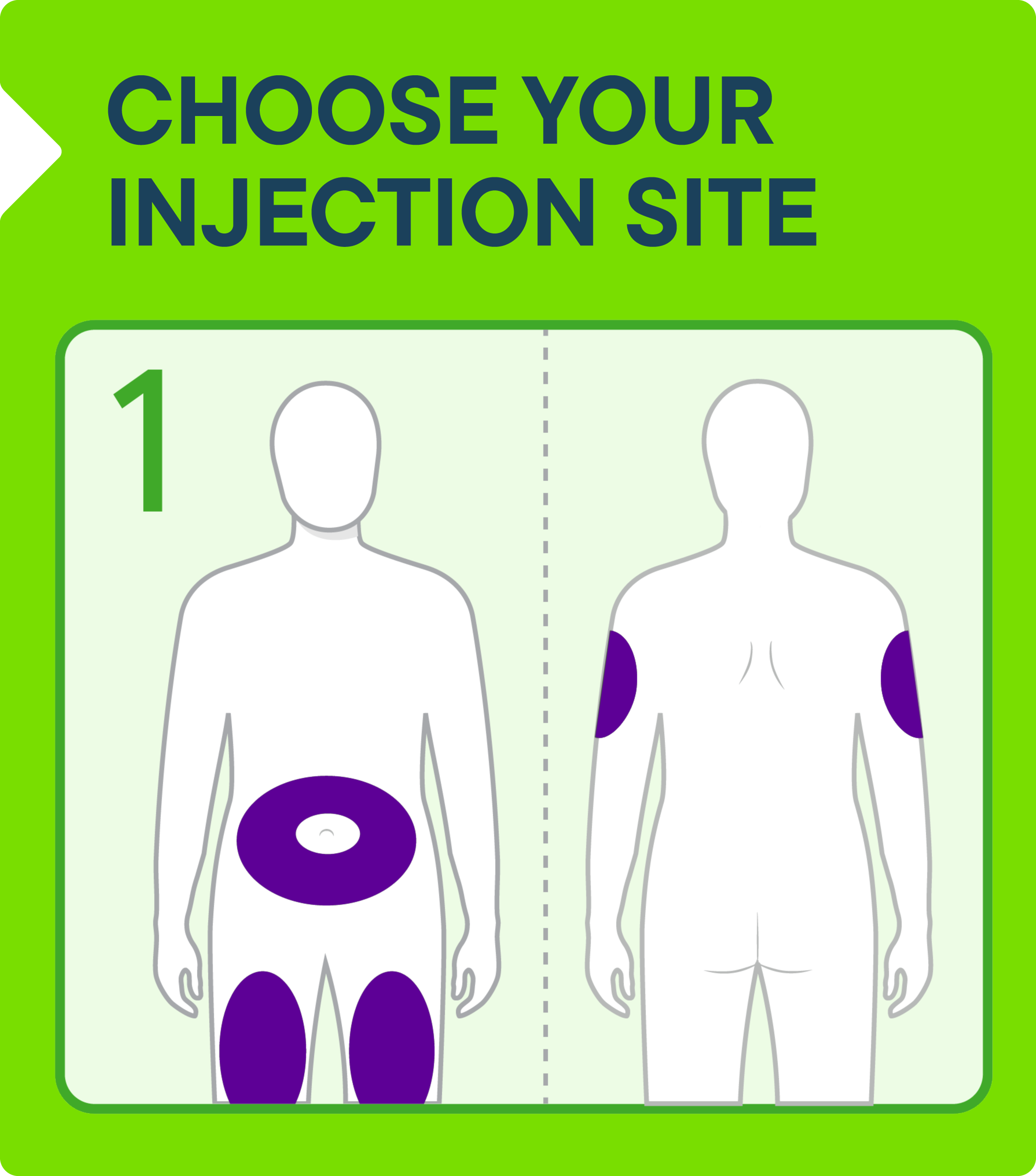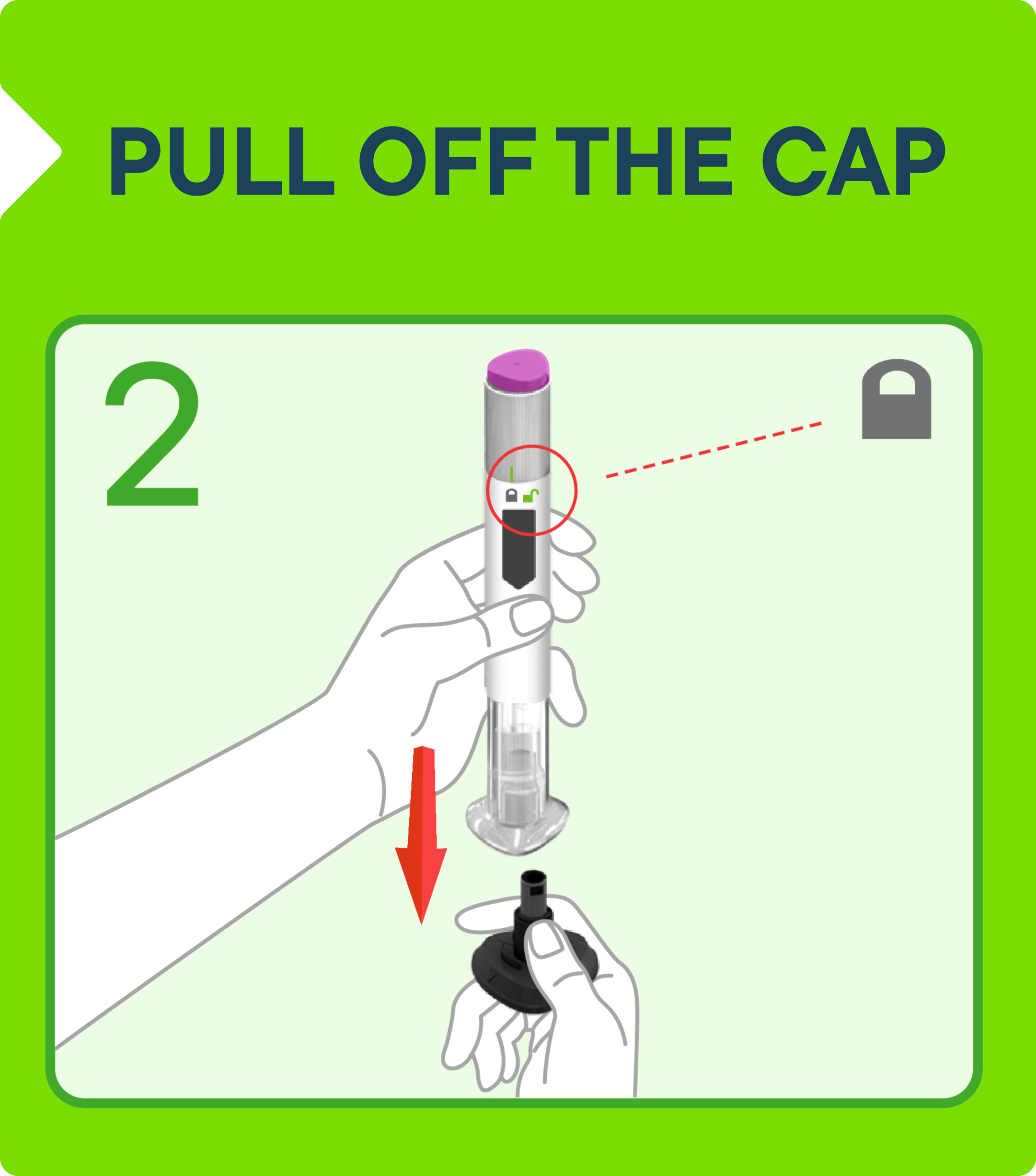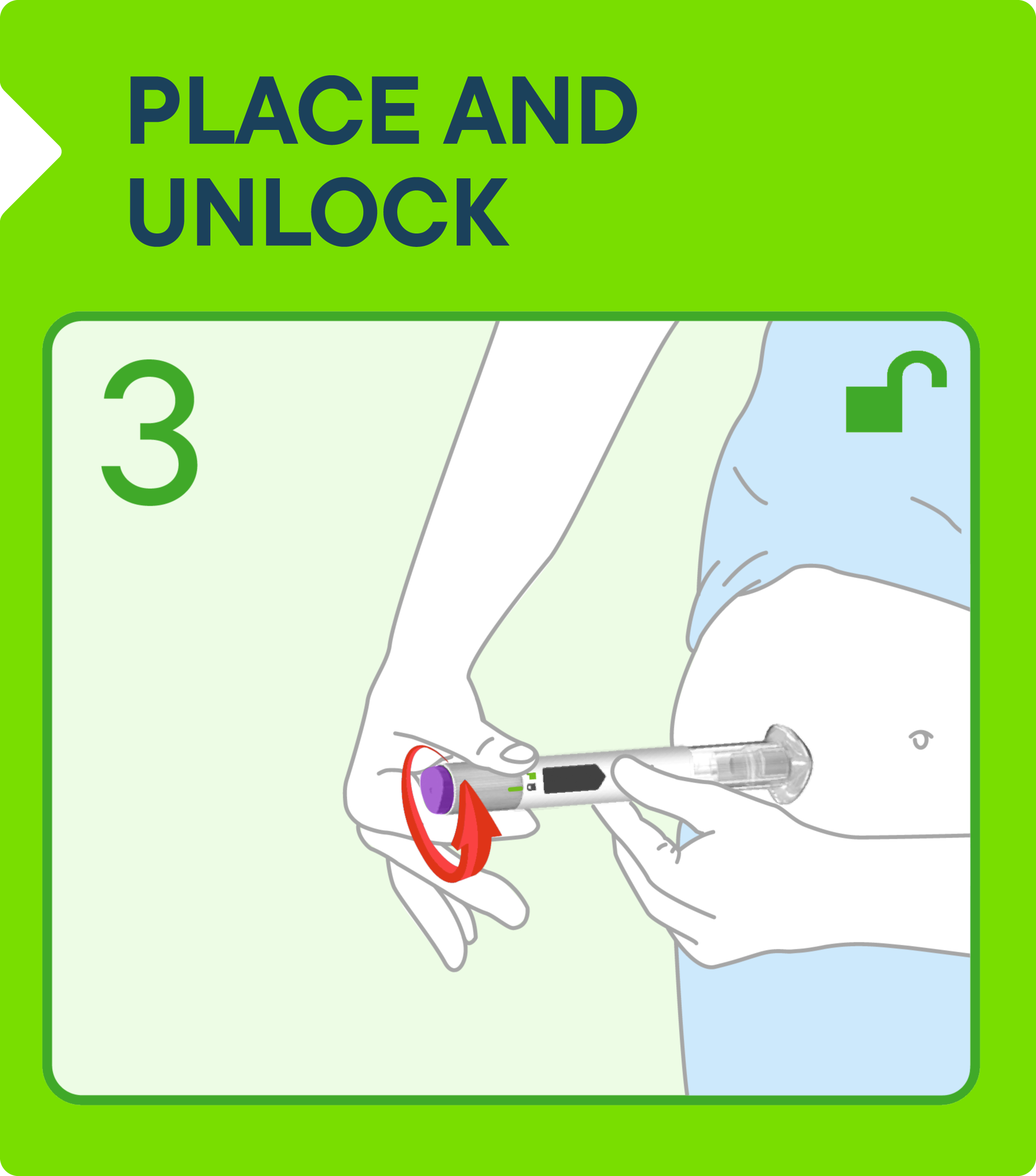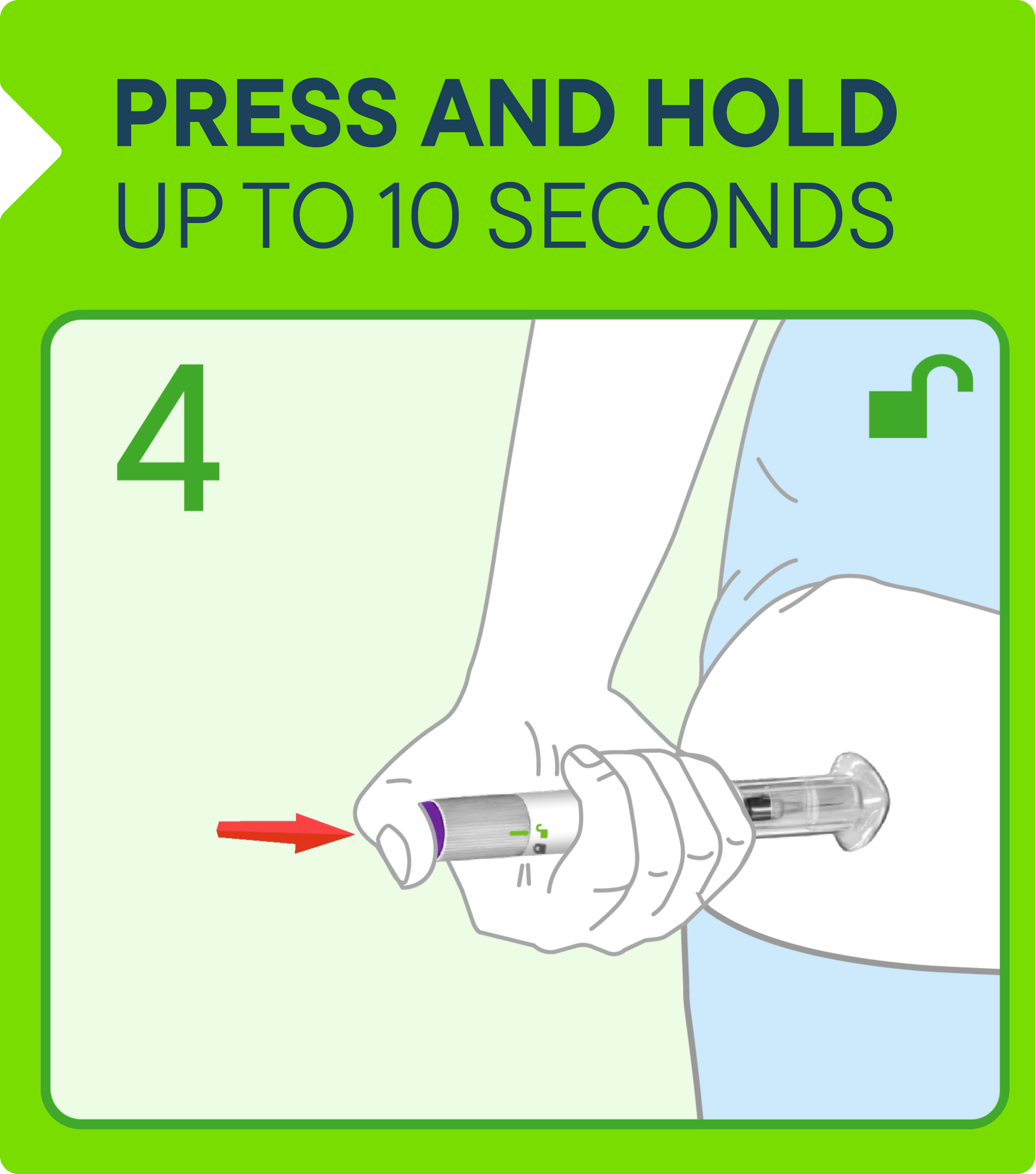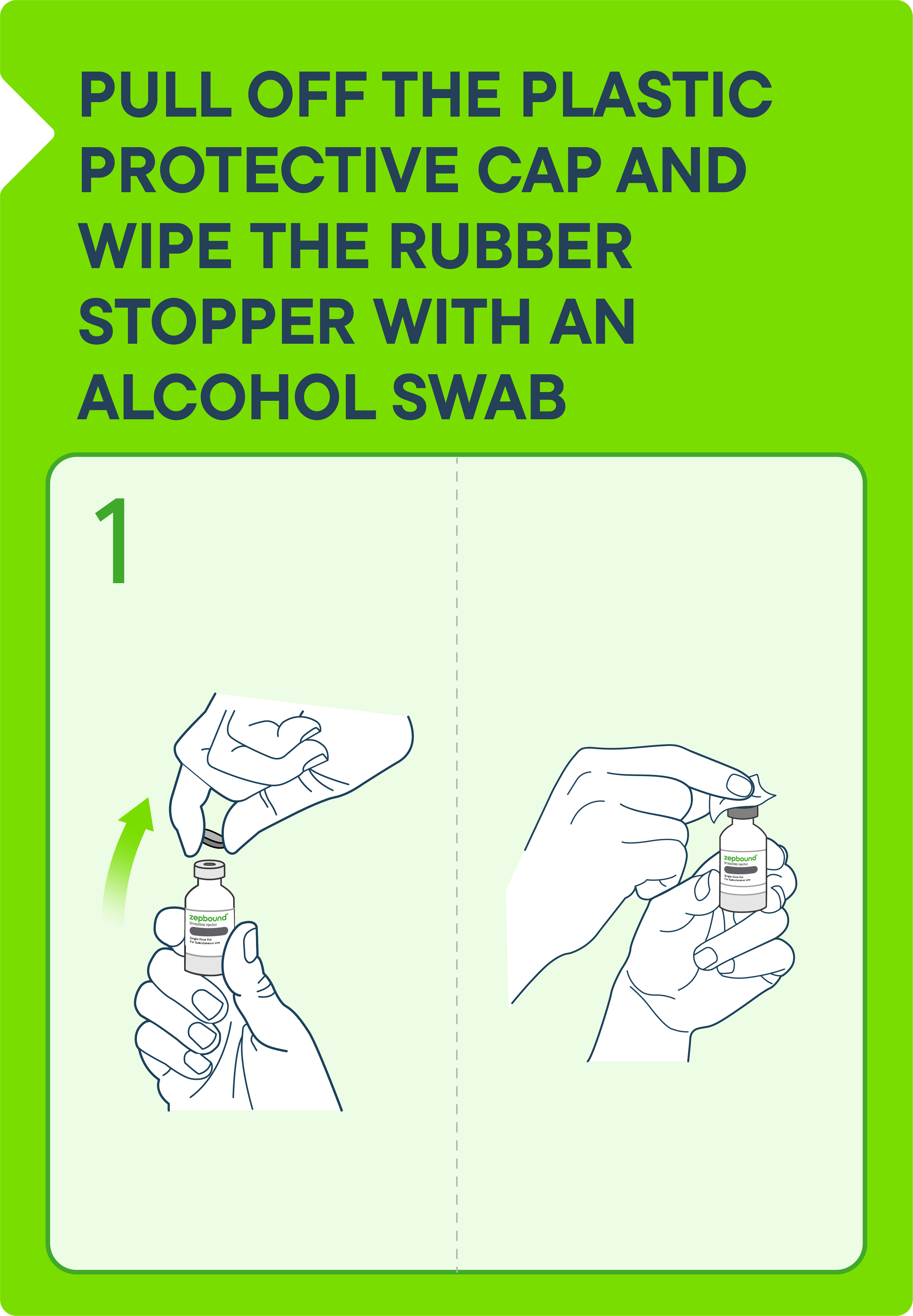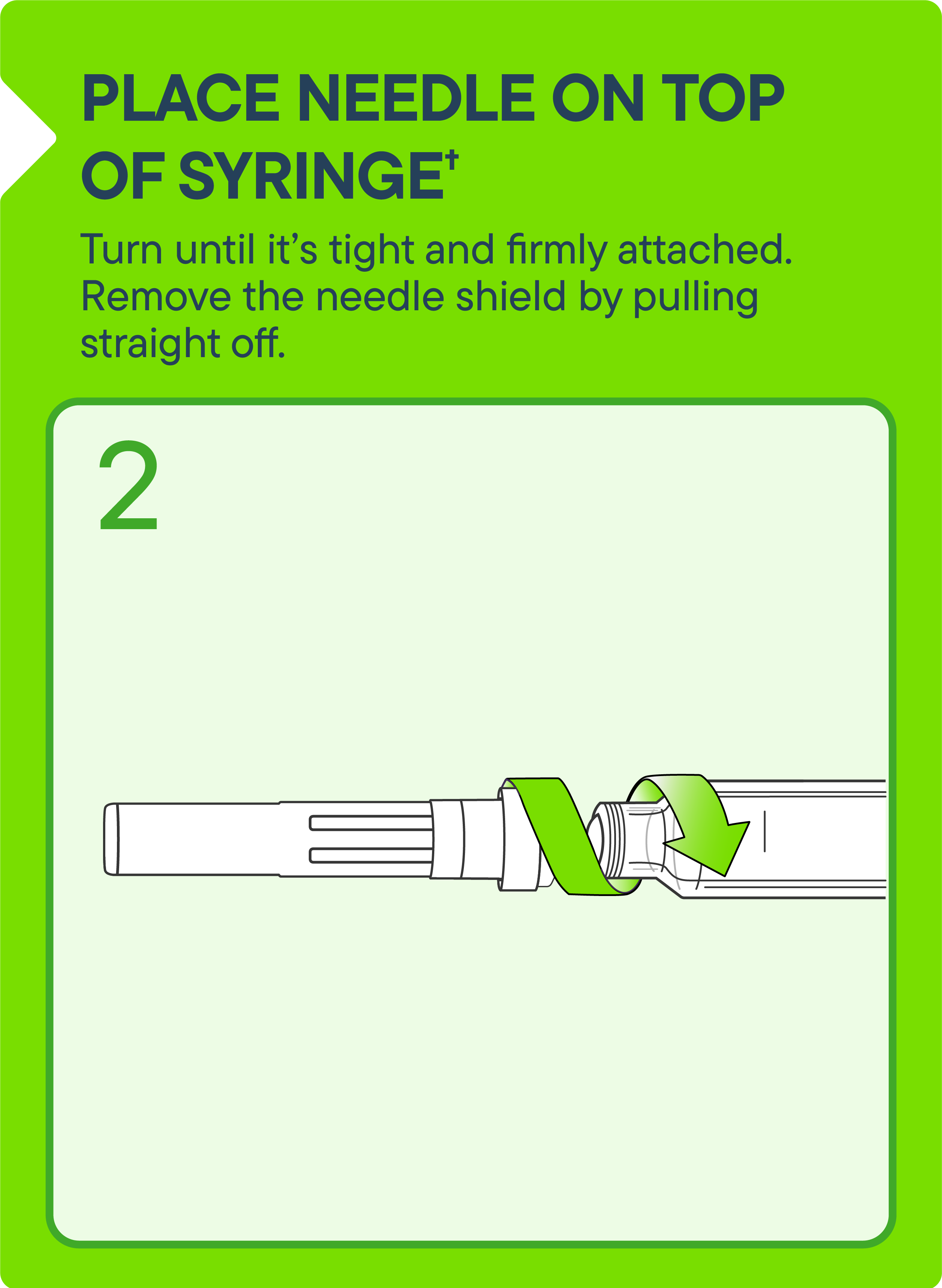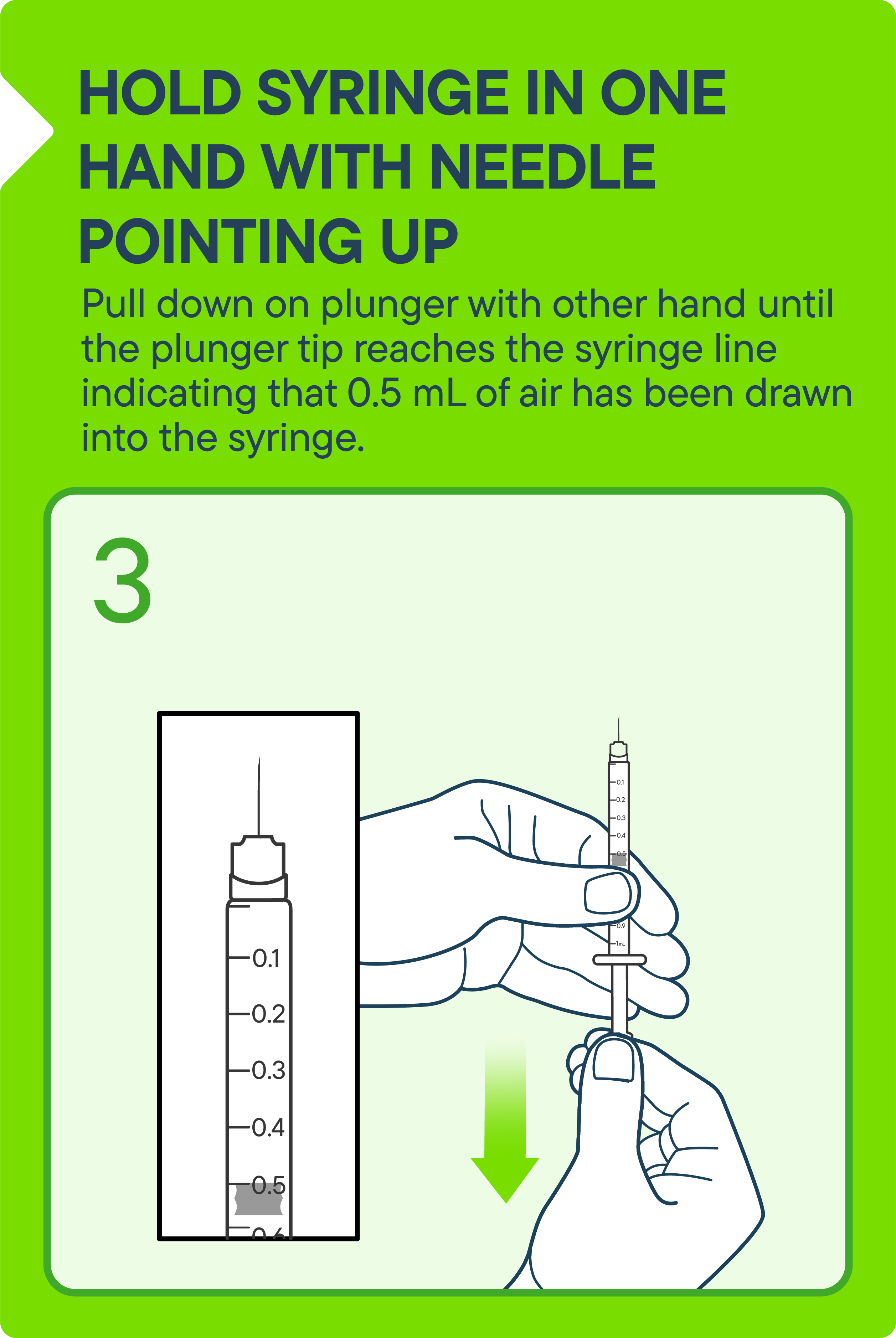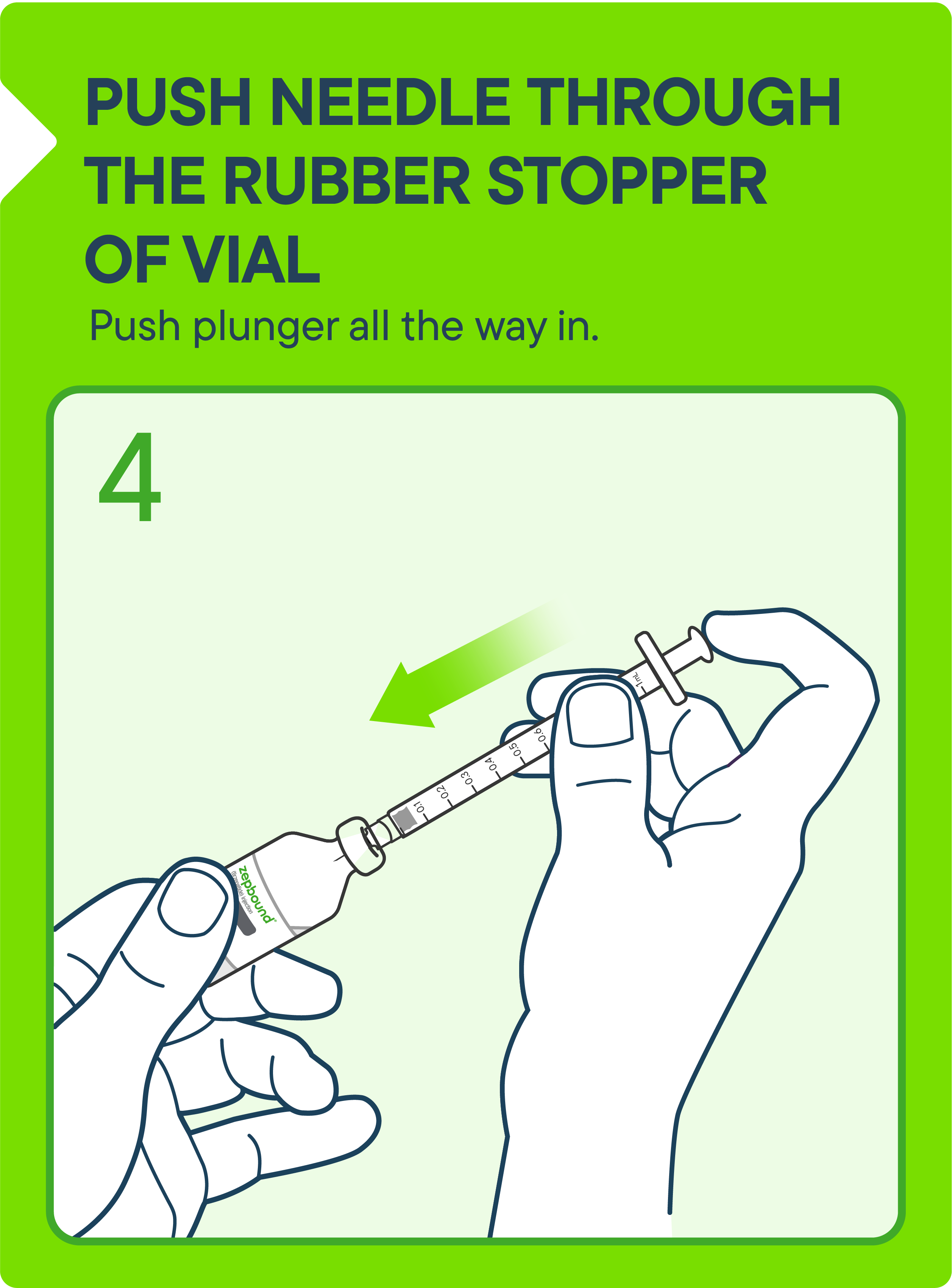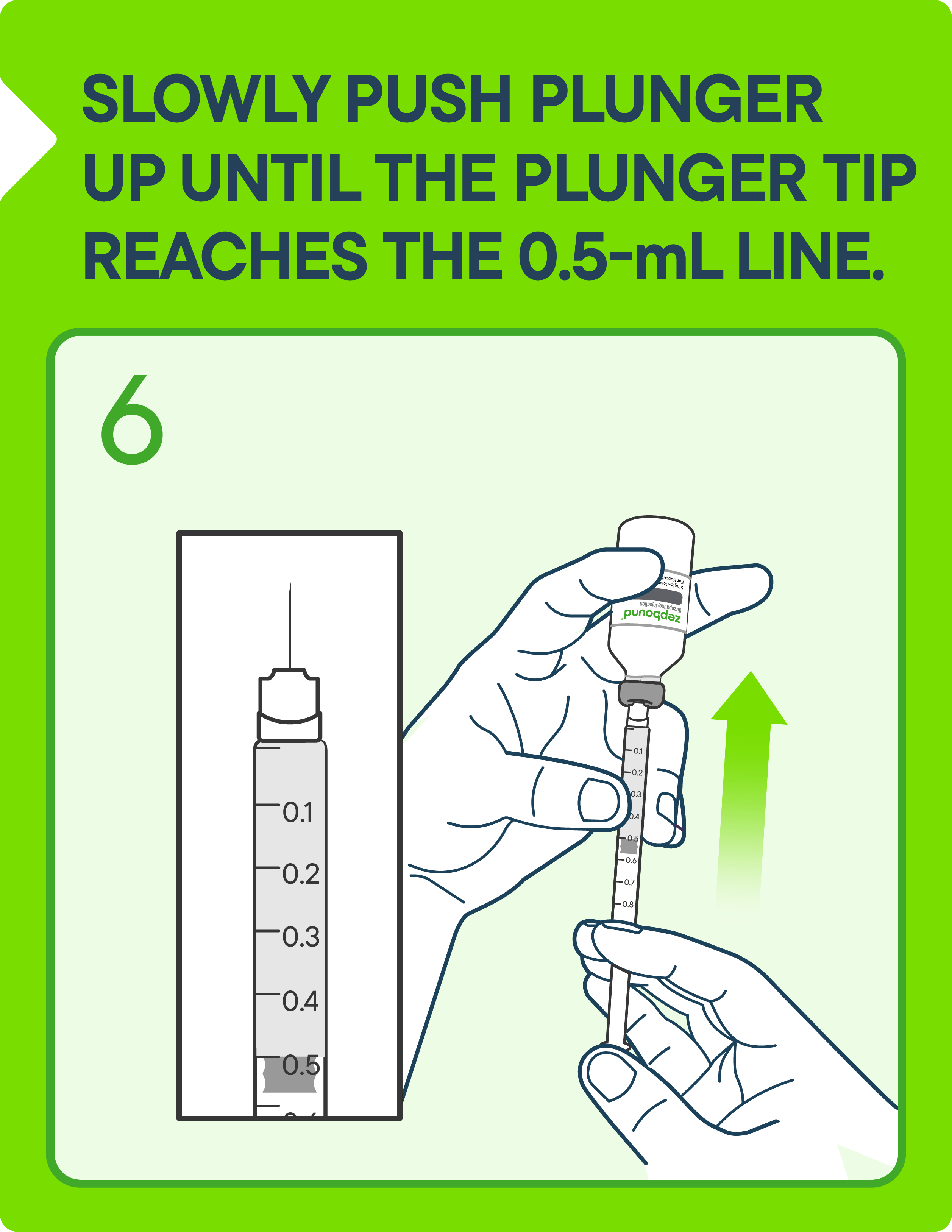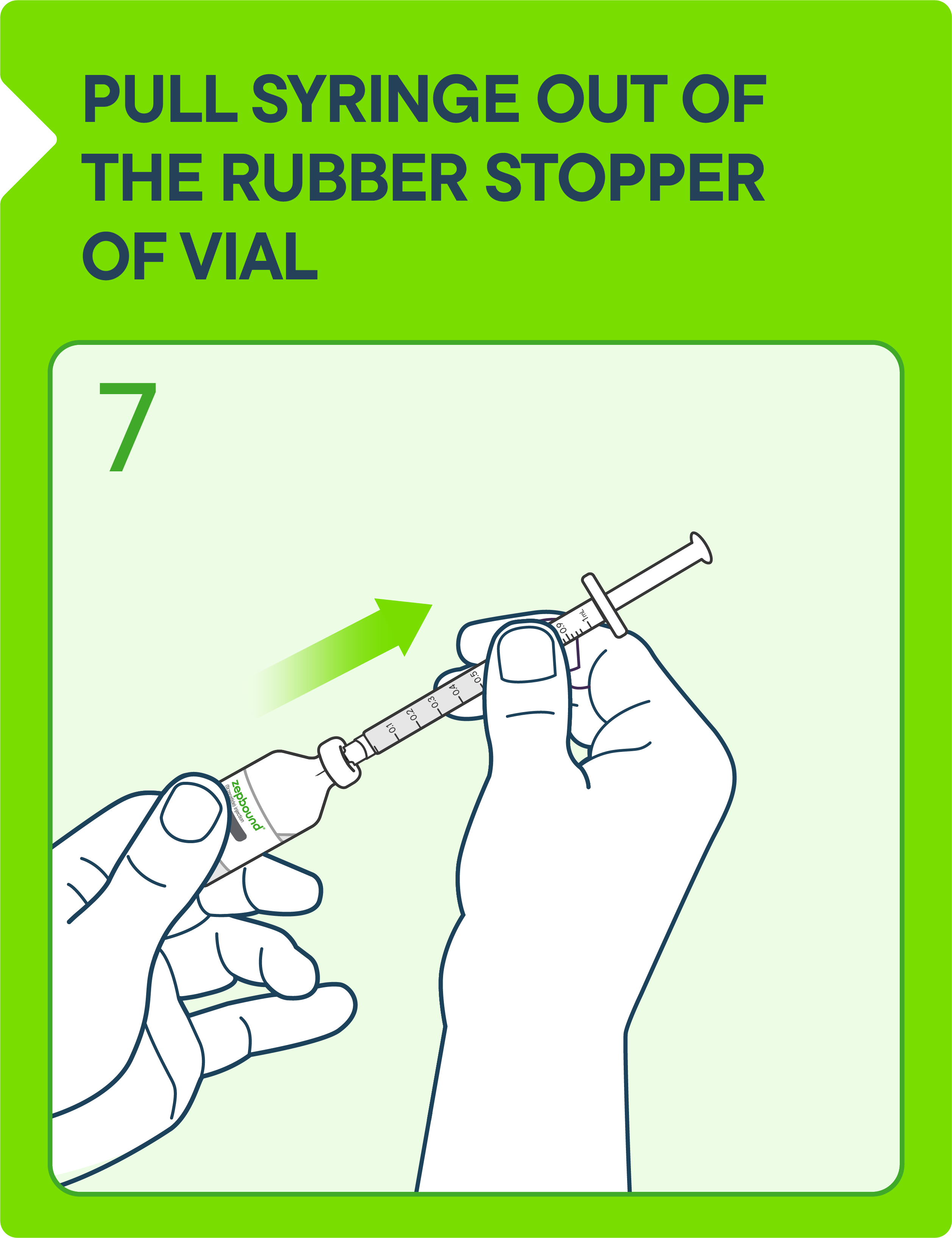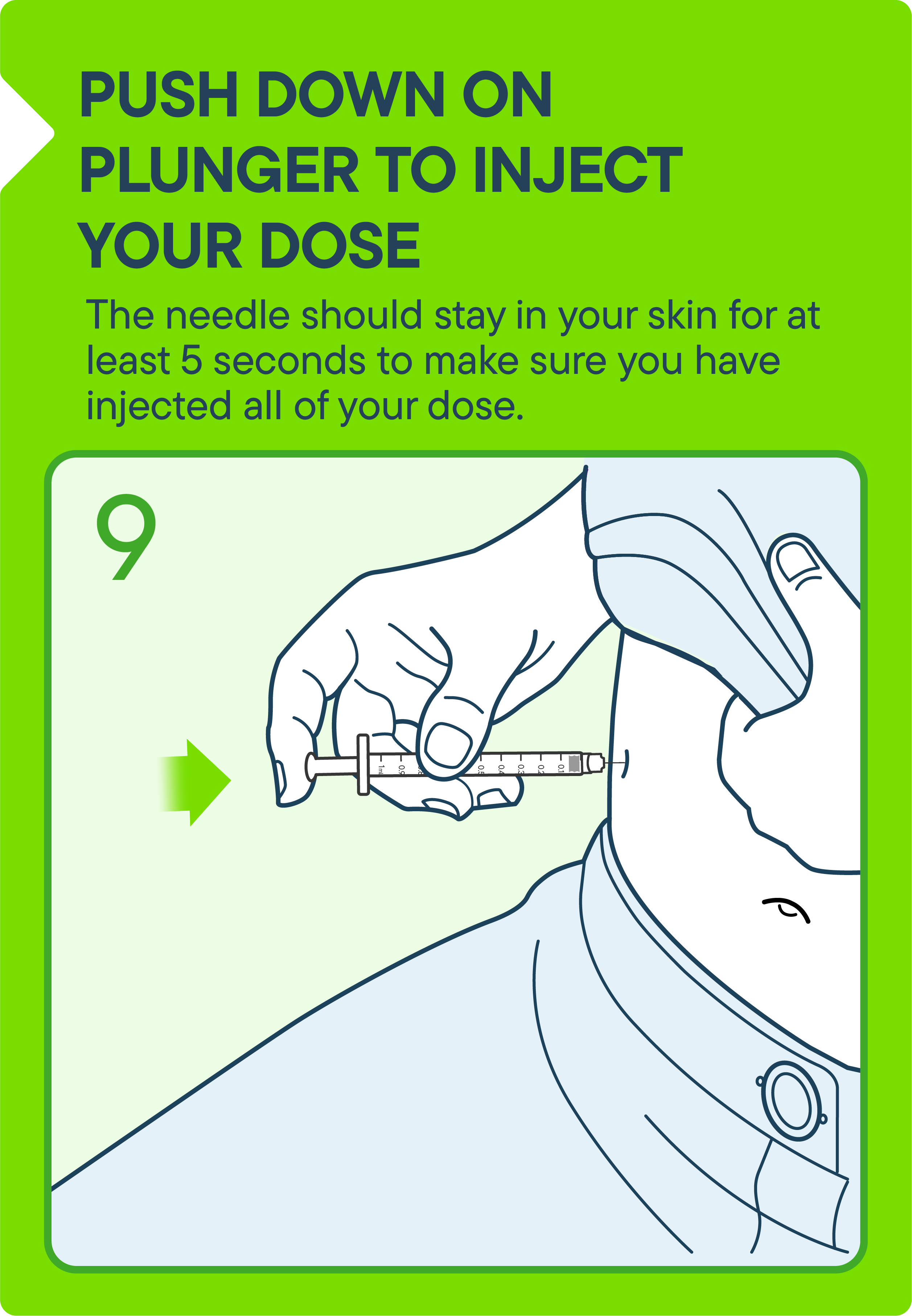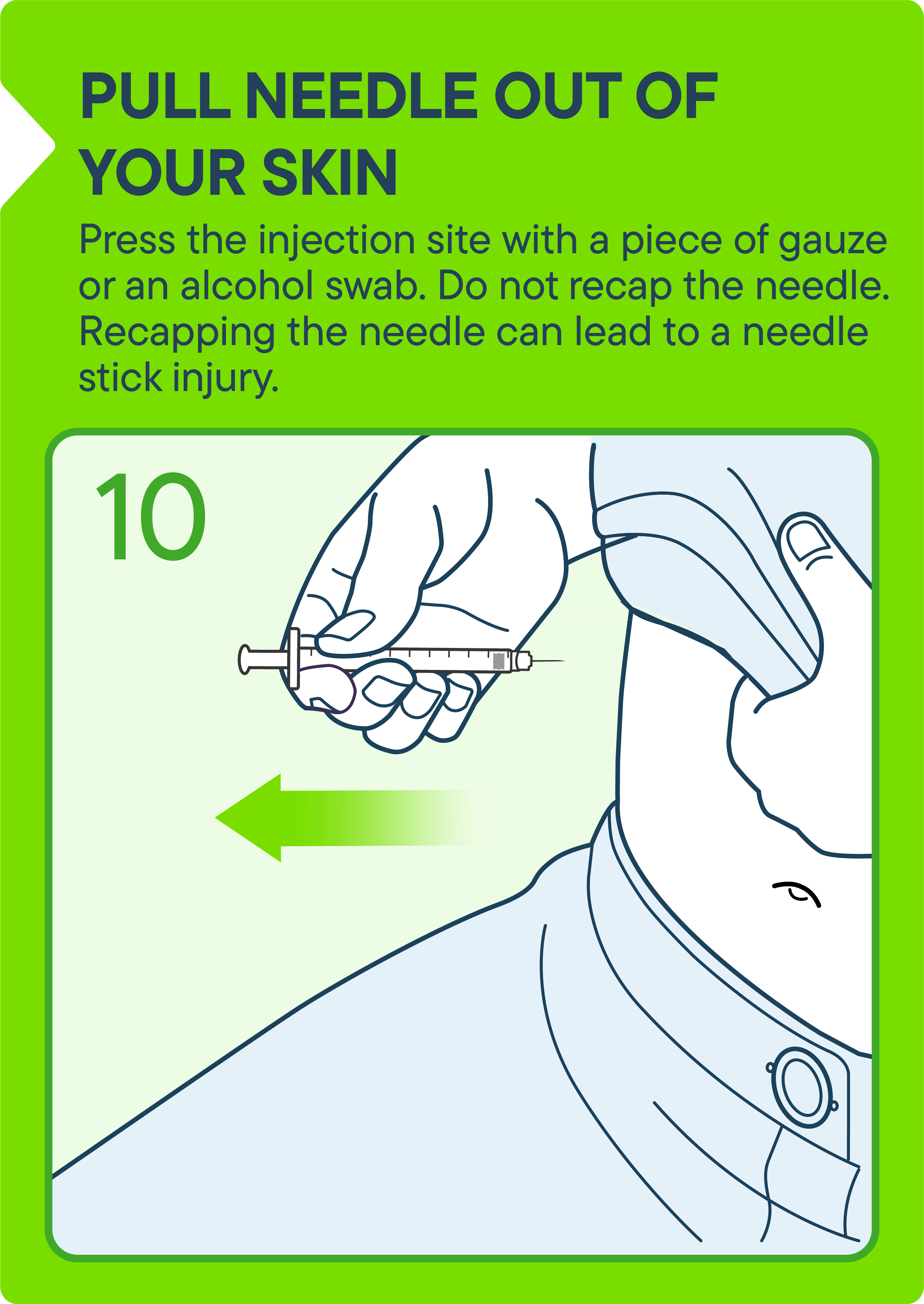
How to use Zepbound 101
Helpful info on using the Zepbound pen & vial
How to use Zepbound 101
Helpful info on using the Zepbound pen & vial
Take Zepbound at home, with or without food, once a week
Zepbound comes in either:
- A single-dose pen. There's no need to see or handle the needle of the pen
- A single-dose vial, administered with a needle and a syringe
Your healthcare provider can help you choose the injection site that is best for you. You or another person can inject the medicine in your stomach or thigh. Another person should give you the injection in the back of your upper arm.
Select a device using the tabs below to learn more:

Prep for Zepbound
Getting started with once-weekly Zepbound injections? See how it’s done in this video.
Please also read the full Instructions for Use that come with your Zepbound pen.
00:00-00:06
[The Zepbound logo and title animate on screen. “Indications and Safety Summary with Warnings”
disclaimer sits
below.]
CAPTION: How to Use | once weekly Zepbound® (tirzepatide) injection 0.5
mL 2.5 mg |
5 mg
| 7.5 mg |
10 mg | 12.5 mg | 15 mg / A Lilly Medicine / See Indications and Safety Summary with Warnings at the end
of this
video.
00:06-00:35
[“Indications and Safety Summary with Warnings” disclaimer fades off screen. Indications and Limitations
of Use
fades on screen.]
CAPTION: How to Use | once weekly Zepbound® (tirzepatide) injection 0.5
mL 2.5 mg | 5 mg | 7.5 mg | 10 mg | 12.5 mg | 15 mg / Lilly Medicine / Indications and Limitations of
Use
NARRATOR: Indications and Limitations of Use. Zepbound is an injectable prescription medicine
that may help
adults with moderate-to-severe obstructive sleep apnea (OSA) and obesity to improve their OSA.
Zepbound should be
used with a reduced-calorie diet and increased physical activity.
Zepbound contains tirzepatide and should not be used with other tirzepatide-containing products or any GLP-1 receptor agonist medicines. It is not known if Zepbound is safe and effective for use in children.
00:35-01:10
[Select Safety Information animates on screen.]
CAPTION: How to Use | once weekly Zepbound® (tirzepatide) injection 0.5
mL 2.5 mg | 5 mg | 7.5 mg | 10 mg | 12.5 mg | 15 mg / A Lilly Medicine /
Select Safety Information
NARRATOR: Select Safety Information. Tell your healthcare provider if you get a lump or swelling
in your
neck, hoarseness, trouble swallowing, or shortness of breath. These may be symptoms of thyroid cancer.
In studies
with rats, Zepbound and medicines that work like Zepbound caused thyroid tumors, including thyroid
cancer. It is
not known if Zepbound will cause thyroid tumors, or a type of thyroid cancer called medullary thyroid
carcinoma
(MTC) in people. Do not take Zepbound if you or any of your family have ever had MTC or if you have an
endocrine
system condition called Multiple Endocrine Neoplasia syndrome type 2 (MEN 2).
01:10-01:15
CAPTION: Prepare for your injection / Zepbound pen and packaging / Always read the
Instructions for
Use and the
Medication Guide
carefully. / The 2.5 mg dose is for treatment initiation and is not intended to be a maintenance dose.
NARRATOR: Always read the Instructions for Use and the Medication Guide carefully.
01:15-01:25
[Title card swipes to reveal Alan. He is welcomingly standing in front of his home office.]
CAPTION: Actor portrayal throughout. / You got this / Please read the full Instructions
for Use
included with your Zepbound Pen.
ALAN: Hey there! I get it. A once-weekly injection is probably not you’re idea of fun, but we’ll
get through
it. You got this!
01:25-01:28
[Alan enters his home kitchen. He stands behind the kitchen counter and confidently rests his hands on
the
countertop.]
CAPTION: Storing the pen
ALAN: We can get started right over here.
01:28-01:33
[Alan turns to open his refrigerator, where the Zepbound box is stored, and removes the box from the
refrigerator.]
CAPTION: 36ºF to 46ºF
ALAN: Store your Zepbound pen in the refrigerator, at 36 to 46 degrees Fahrenheit.
01:33-01:40
[Alan places Zepbound box on kitchen counter, opens it, and removes 1 of his 4 Zepbound pens, and places
it on the
countertop, and then closes the box.]
ALAN: There are four in each box, but you’ll only use one each week.
01:40-01:55
[Alan puts the Zepbound box back in the refrigerator and confidently returns to the kitchen counter to
continue with
his instruction.]
CAPTION: Store your pen in the original carton to protect your pen from light / You can
store your
pen at room temperature up to 86°F (30°C) for up to 21 days. If you store the pen at room temperature,
do not return
the pen to the refrigerator.
ALAN: You can also store your pens at room temperature up to 86 degrees Fahrenheit for up to 21
days. If you
do that, though, make sure you don’t return the pen to the refrigerator.
1:55-02:03
[Alan warmly holds his Zepbound pen up at chest height. Zoom in on Zepbound pen.]
CAPTION: Top | Purple injection button | Lock ring | Indicator | Lock or unlock |
Medicine | Clear
base | Gray base cap | Bottom and needle end
ALAN: Here, take a look at the pen.
02:03-02:24
[Alan returns to home office enthusiastically holding his Zepbound pen. A checklist animates on screen
as Alan
describes how to properly inspect the pen.]
CAPTION: CORRECT DOSE | NOT EXPIRED | NOT DAMAGED | NOT FROZEN | COLORLESS TO SLIGHTLY
YELLOW | NOT
CLOUDY | NO PARTICLES / Always inspect your pen prior to injection.
ALAN: Before you inject, wash your hands, and check the pen label to make sure that you have the
right
medicine and dose, and that it hasn’t expired. Also, inspect the pen to make sure that it isn’t
damaged, and that
the medicine isn’t frozen. The medicine should be colorless to slightly yellow—not cloudy, and there
should be no
particles.
02:24-02:28
[The checklist animates off screen as Alan wholesomely introduces us to the 4 steps for how to use
Zepbound.]
CAPTION: 4 steps / These 4 steps are not the complete instructions for using Zepbound.
Before
starting Zepbound, your healthcare provider should show you how to use the Zepbound pen. Please read the
full
Instructions for Use included with your pen.
ALAN: So far, so good? I’ve got four steps for you.
02:28-02:47
[Step 1 graphic animates on screen. The graphic highlights the stomach, thighs, and back of the upper
arms on a
silhouette. Alan delivers the first step.]
CAPTION: 1 CHOOSE YOUR INJECTION SITE / Please read the full Instructions for Use
included with your
Zepbound pen.
ALAN: First, choose your injection site. If you like, your doctor can help you with your choice.
You can
inject in your stomach or your thighs yourself, or the back of your upper arms with someone’s help.
It’s okay to
use the same area every week, but avoid injecting in the exact same spot. Today, I’ll go with my
stomach.
02:47-02:55
[Close up of Alan holding his Zepbound pen just below chest height. The Step 2 graphic animates on
screen. The
graphic displays the Zepbound pen in the locked position and the gray base cap being removed.]
CAPTION: 2 PULL OFF THE CAP / Please read the full Instructions for Use included with
your Zepbound
pen.
ALAN: And we’re already at Step 2. Make sure the pen is locked. Leave it locked until you place
it on
your skin to
inject.
02:55-03:03
[Alan turns away to throw the gray base cap into his household trash. He turns back to resume his
position by the
Step 2 graphic.]
CAPTION: 2 PULL OFF THE CAP / Please read the full Instructions for Use included with
your Zepbound
pen.
ALAN: Pull the gray base cap straight off and throw it away in your household trash. Don’t touch
the needle
or put the gray base cap back on.
03:03-03:10
[Alan lifts his shirt to expose his stomach. The Step 3 graphic animates on screen. The graphic displays
how to
place the Zepbound pen against one’s stomach and how to unlock it. Alan places his Zepbound pen on his
stomach and
turns the lock ring.
CAPTION: 3. PLACE AND UNLOCK / Please read the full Instructions for Use included with
your Zepbound
pen.
ALAN: Step 3. Place the clear base flat against your skin and unlock the pen by turning the lock
ring.
03:10-03:30
[Close up of Alan holding Zepbound pen against his stomach. Step 4 graphic animates on screen. The
graphic displays
how to press the purple button when the pen is unlocked. Alan presses the purple button of his Zepbound
pen.]
CAPTION: 4 PRESS AND HOLD UP TO 10 SECONDS / Please read the full Instructions for Use
included with
your Zepbound pen
ALAN: And we’re at Step 4. Press and hold the purple button for up to 10 seconds. You’ll hear
the first
click when it starts. Keep holding until you hear the second click, which means you’re done. Even if
you don’t
feel a poke, if you hear two clicks and see the gray plunger, the injection is complete.
03:30-03:34
[Alan is confidently standing behind his kitchen counter with his used Zepbound pen. An empty detergent
bottle that
has been labeled “SHARPS” and an FDA-cleared sharps container rest on the countertop in front of him.]
CAPTION: That’s it / Safely dispose of the used pen immediately after use. Do not throw
away pens in
the household trash. Please read the full Instructions for Use included with your Zepbound pen.
ALAN: And that’s it! The steps are the same for any dose.
03:34-03:39
[Alan securely disposes of his used Zepbound pen with the FDA-approved sharps container.]
ALAN: Afterward, safely dispose of the used pen in an FDA-cleared sharps container.
03:39-03:59
[Alan turns his attention to the empty detergent bottle that has been labeled “SHARPS.”]
ALAN: If you don’t have one, you can use a heavy-duty plastic household container, like an empty
detergent
bottle, that’s upright and stable. Make sure it can be closed with a tight-fitting, puncture-resistant
lid, is
leak-resistant, and is properly labeled as hazardous waste. And keep your Zepbound pen and all
medicines out of
the reach of children.
03:59-04:09
[Swipe to reveal Alan back in his home office. He is standing enthusiastically in front of his desk with
an assured
smile.]
ALAN: Once you get the hang of weekly injections, they’ll become a part of your routine. If you
need
more support,
just talk to your doctor or explore Zepbound.com.
04:09-04:13
[Swipe to white as the Zepbound logo animates in.]
CAPTION: once weekly Zepbound® (tirzepatide) injection 0.5 mL 2.5 mg | 5
mg | 7.5 mg
|
10 mg | 12.5
mg | 15 mg
04:13-11:32
[The Zepbound logo fades out before Indications and Safety Summary with Warnings fades in and begins to
scroll.]
CAPTION: once weekly Zepbound® (tirzepatide) injection 0.5 mL 2.5 mg | 5
mg | 7.5 mg
| 10 mg | 12.5 mg | 15 mg / INDICATIONS AND SAFETY SUMMARY WITH WARNINGS
NARRATOR: INDICATIONS AND SAFETY SUMMARY WITH WARNINGS. Zepbound® is an injectable
prescription
medicine that may
help adults with:
• obesity, or some adults with overweight who also have weight-related medical problems to lose excess
body weight
and keep the weight off.
• moderate-to-severe obstructive sleep apnea (OSA) and obesity to improve their OSA.
It should be used with a reduced-calorie diet and increased physical activity.
Zepbound contains tirzepatide and should not be used with other tirzepatide-containing products or any GLP-1 receptor agonist medicines. It is not known if Zepbound is safe and effective for use in children.
Warnings. Zepbound may cause tumors in the thyroid, including thyroid cancer. Watch for possible symptoms, such as a lump or swelling in the neck, hoarseness, trouble swallowing, or shortness of breath. If you have any of these symptoms, tell your healthcare provider.
Do not use Zepbound if you or any of your family have ever had a type of thyroid cancer called medullary thyroid carcinoma (MTC). Do not use Zepbound if you have Multiple Endocrine Neoplasia syndrome type 2 (MEN 2). Do not use Zepbound if you have had a serious allergic reaction to tirzepatide or any of the ingredients in Zepbound.
Zepbound may cause serious side effects, including:
Severe stomach problems. Stomach problems, sometimes severe, have been reported in people who use Zepbound. Tell your healthcare provider if you have stomach problems that are severe or will not go away.
Kidney problems (kidney failure). Diarrhea, nausea, and vomiting may cause a loss of fluids (dehydration), which may cause kidney problems. It is important for you to drink fluids to help reduce your chance of dehydration.
Gallbladder problems. Gallbladder problems have happened in some people who use Zepbound. Tell your healthcare provider right away if you get symptoms of gallbladder problems, which may include pain in your upper stomach (abdomen), fever, yellowing of skin or eyes (jaundice), or clay-colored stools.
Inflammation of the pancreas (pancreatitis). Stop using Zepbound and call your healthcare provider right away if you have severe pain in your stomach area (abdomen) that will not go away, with or without vomiting. You may feel the pain from your abdomen to your back.
Serious allergic reactions. Stop using Zepbound and get medical help right away if you have any symptoms of a serious allergic reaction, including swelling of your face, lips, tongue or throat, problems breathing or swallowing, severe rash or itching, fainting or feeling dizzy, or very rapid heartbeat.
Low blood sugar (hypoglycemia). Your risk for getting low blood sugar may be higher if you use Zepbound with medicines that can cause low blood sugar, such as a sulfonylurea or insulin. Signs and symptoms of low blood sugar may include dizziness or light-headedness, sweating, confusion or drowsiness, headache, blurred vision, slurred speech, shakiness, fast heartbeat, anxiety, irritability, mood changes, hunger, weakness or feeling jittery.
Changes in vision in patients with type 2 diabetes. Tell your healthcare provider if you have changes in vision during treatment with Zepbound.
Depression or thoughts of suicide. You should pay attention to changes in your mood, behaviors, feelings or thoughts. Call your healthcare provider right away if you have any mental changes that are new, worse, or worry you.
Food or liquid getting into the lungs during surgery or other procedures that use anesthesia or deep sleepiness (deep sedation). Zepbound may increase the chance of food getting into your lungs during surgery or other procedures. Tell all your healthcare providers that you are taking Zepbound before you are scheduled to have surgery or other procedures.
Common side effects. The most common side effects of Zepbound include nausea, diarrhea, vomiting, constipation, stomach (abdominal) pain, indigestion, injection site reactions, feeling tired, allergic reactions, belching, hair loss, and heartburn. These are not all the possible side effects of Zepbound. Talk to your healthcare provider about any side effect that bothers you or doesn’t go away.
Tell your doctor if you have any side effects. You can report side effects at 1-800-FDA-1088 or www.fda.gov/medwatch.
Before using Zepbound. Your healthcare provider should show you how to use Zepbound before you use it for the first time. Tell your healthcare provider if you are taking medicines to treat diabetes including an insulin or sulfonylurea which could increase your risk of low blood sugar. Talk to your healthcare provider about low blood sugar levels and how to manage them. If you take birth control pills by mouth, talk to your healthcare provider before you use Zepbound. Birth control pills may not work as well while using Zepbound. Your healthcare provider may recommend another type of birth control for 4 weeks after you start Zepbound and for 4 weeks after each increase in your dose of Zepbound.
Review these questions with your healthcare provider. Do you have other medical conditions, including problems with your pancreas or kidneys, or severe problems with your stomach, such as slowed emptying of your stomach (gastroparesis) or problems digesting food? Do you take diabetes medicines, such as insulin or sulfonylureas? Do you have a history of diabetic retinopathy? Are you scheduled to have surgery or other procedures that use anesthesia or deep sleepiness (deep sedation)? Do you take any other prescription medicines or over-the-counter drugs, vitamins, or herbal supplements? Are you pregnant, plan to become pregnant, breastfeeding, or plan to breastfeed? Zepbound may harm your unborn baby. Tell your healthcare provider if you become pregnant while using Zepbound. It is not known if Zepbound passes into your breast milk. You should talk with your healthcare provider about the best way to feed your baby while using Zepbound.
Pregnancy Exposure Registry: There will be a pregnancy exposure registry for women who have taken Zepbound during pregnancy. The purpose of this registry is to collect information about the health of you and your baby. Talk to your healthcare provider about how you can take part in this registry, or you may contact Lilly at 1-800-LillyRx (1-800-545-5979).
How to take. Read the Instructions for Use that come with Zepbound. Use Zepbound exactly as your healthcare provider says. Use Zepbound with a reduced-calorie diet and increased physical activity. Zepbound is injected under the skin (subcutaneously) of your stomach (abdomen), thigh, or upper arm. Use Zepbound 1 time each week, at any time of the day. Change (rotate) your injection site with each weekly injection. Do not use the same site for each injection. If you take too much Zepbound, call your healthcare provider, seek medical advice promptly, or contact a Poison Center expert right away at 1-800-222-1222.
Zepbound injection is approved as a 2.5 mg, 5 mg, 7.5 mg, 10 mg, 12.5 mg, or 15 mg per 0.5 mL in single-dose pen or single-dose vial.
Learn more. Zepbound is a prescription medicine. For more information, call 1-800-LillyRx (1-800-545-5979) or go to www.zepbound.lilly.com.
This summary provides basic information about Zepbound but does not include all information known about this medicine. Read the information that comes with your prescription each time your prescription is filled. This information does not take the place of talking with your healthcare provider. Be sure to talk to your healthcare provider about Zepbound and how to take it. Your healthcare provider is the best person to help you decide if Zepbound is right for you.
ZP CON BS 20DEC2024
Zepbound® and its delivery device base are registered trademarks owned or licensed by Eli Lilly and Company, its subsidiaries, or affiliates.
11:32-11:35
[Dissolve to red screen as the Lilly: A Medicine Company logo fades in.]
CAPTION: Lilly
A MEDICINE COMPANY
PP-ZP-US-1049 01/2025 ©Lilly USA, LLC 2025. All rights reserved.
Zepbound® and its delivery device base are registered trademarks owned or licensed by Eli
Lilly and
Company, its
subsidiaries, or affiliates.
This injection guide can help too*
After you inspect your pen, follow these 4 steps to use Zepbound:
- Choose your injection site.
- Pull off the cap.
- Place and unlock.
- Press and hold up to 10 seconds.
Even if you don’t feel a poke, if you hear 2 clicks, the injection is complete! You will know you are done when the gray plunger is visible.
*These 4 steps are not the complete instructions for using Zepbound. Before starting Zepbound, your healthcare provider should show you how to use the Zepbound pen. Always inspect your pen prior to injection and read the full Instructions for Use included with your Zepbound pen or scroll up to watch the How to Use Zepbound video.
Check the authenticity of your medicine
Click the button below to check the authenticity of your medicine and see what genuine Zepbound looks like.
Check authenticity
Watch and learn: A step-by-step guide to your Zepbound vial
Please read the full Instructions for Use included with your Zepbound vial.
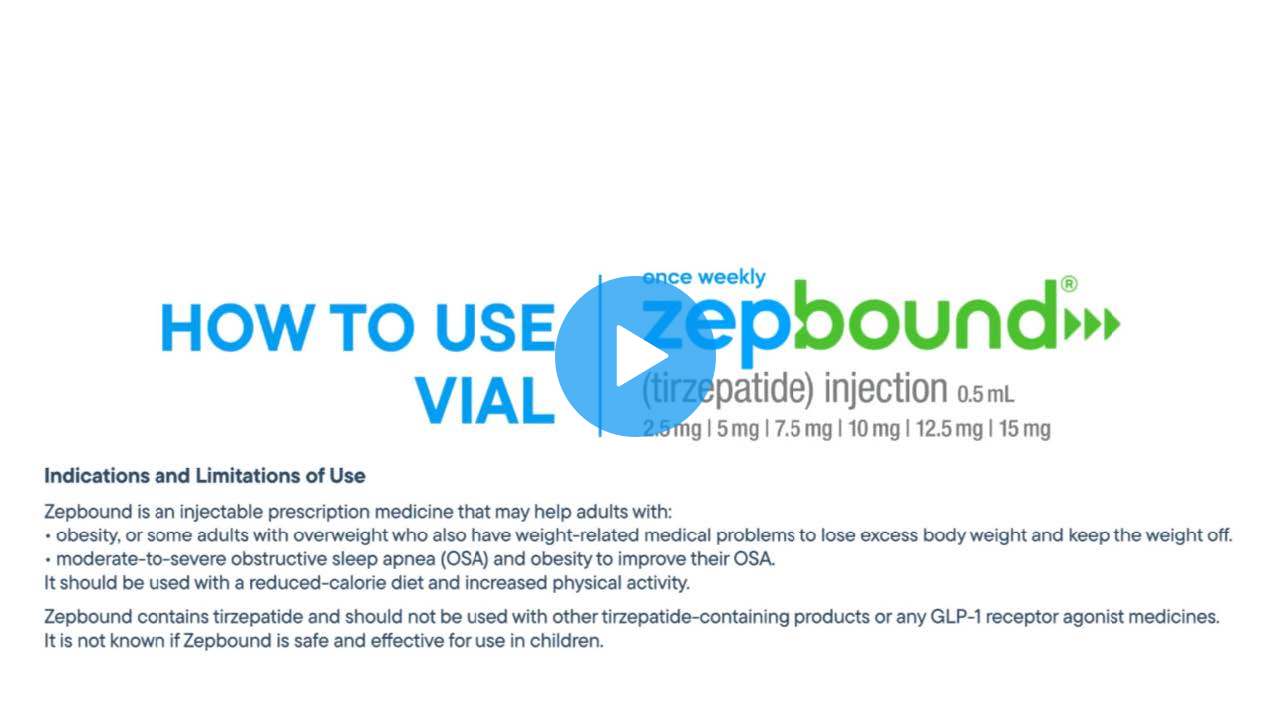
00:00-00:46
[The Zepbound logo animates on screen, followed by the Indications and Limitations of Use. Upbeat music plays.]
CAPTION: HOW TO USE once weekly Zepbound® (tirzepatide) injection 0.5 mL 2.5 mg |
5 mg | 7.5 mg | 10 mg | 12.5 mg | 15 mg
Indications and Limitations of Use
NARRATOR: Indications and Limitations of Use. Zepbound is an injectable prescription medicine that may
help adults with obesity, or some adults with overweight who also have weight-related medical problems, to lose
excess body weight and keep the weight off. It may also help adults with moderate-to-severe obstructive sleep apnea (OSA) and obesity to improve their OSA. It should be used with a reduced-calorie diet and increased physical activity.
Zepbound contains tirzepatide and should not be used with other tirzepatide-containing products or any GLP-1 receptor agonist medicines. It is not known if Zepbound is safe and effective for use in children.
00:46-01:23
[Select Safety Information animates on screen.]
CAPTION: HOW TO USE once weekly Zepbound® (tirzepatide) injection 0.5 mL 2.5 mg |
5 mg | 7.5 mg | 10 mg | 12.5 mg | 15 mg
Select Safety Information
NARRATOR: Select Safety Information. Tell your healthcare provider if you get a lump or swelling in your
neck, hoarseness, trouble swallowing, or shortness of breath. These may be symptoms of thyroid cancer. In
studies with rats, Zepbound and medicines that work like Zepbound caused thyroid tumors, including thyroid
cancer. It is not known if Zepbound will cause thyroid tumors, or a type of thyroid cancer called medullary
thyroid carcinoma (MTC) in people. Do not take Zepbound if you or any of your family have ever had MTC or if you
have an endocrine system condition called Multiple Endocrine Neoplasia syndrome type 2 (MEN 2).
01:23-01:28
CAPTION: HOW TO USE once weekly Zepbound® (tirzepatide) injection 0.5 mL 2.5 mg |
5 mg | 7.5 mg | 10 mg | 12.5 mg | 15 mg
NARRATOR: See Indications and Safety Summary with Warnings at the end of this video.
01:28-01:34
CAPTION: HOW TO USE once weekly Zepbound® (tirzepatide) injection 0.5 mL 2.5 mg |
5 mg | 7.5 mg | 10 mg | 12.5 mg | 15 mg
NARRATOR: In this video you will learn how to inject Zepbound using the single-dose vial and a needle and
a syringe.
01:34-01:50
[An illustration of a refrigerator animates on screen. The Zepbound logo appears and remains on screen in the
lower right-hand corner.]
CAPTION: Getting started with your Zepbound® (tirzepatide) injection
Read the Instructions for Use before you start taking Zepbound and each time you get a new vial.
Do not share your needles or syringes with other people. You may give other people a serious infection or get a
serious infection from them.
NARRATOR: Be sure to read the Instructions for Use before you start taking Zepbound and each time you get
a new vial. There may be new information. This information does not take the place of talking to your healthcare
provider about your medical condition or your treatment.
01:50-01:59
[A carton of Zepbound animates on screen.]
CAPTION: Getting started with your Zepbound® (tirzepatide) injection
Read the Instructions for Use before you start taking Zepbound and each time you get a new vial.
Do not share your needles or syringes with other people. You may give other people a serious infection or get a
serious infection from them.
NARRATOR: Do not share your needles or syringes with other people. You may give other people a serious
infection or get a serious infection from them.
01:59-02:15
[A carton of Zepbound and vial animate on screen.]
CAPTION: Getting started with your Zepbound® (tirzepatide) injection
Read the Instructions for Use before you start taking Zepbound and each time you get a new vial.
Do not share your needles or syringes with other people. You may give other people a serious infection or get a
serious infection from them.
NARRATOR: The Zepbound single-dose vial is a subcutaneous injection, which means it is injected under the
skin. Ready to learn how to use the Zepbound single-dose vial? Let’s begin with preparing for your once-weekly
injection.
02:15-02:21
[An illustration of the inside of an open refrigerator door animates on screen, highlighting a carton of Zepbound
on one of the shelves.]
CAPTION: Preparing for your Zepbound® injection
• Remove the vial from the refrigerator
NARRATOR: Remove the vial from the refrigerator. Remove the single-dose vial from the carton.
02:21-02:29
[The refrigerator illustration fades away as the animation zooms in on a Zepbound vial.]
CAPTION: The Zepbound® vial
• Check the medicine and dose
• Check that it has not expired
NARRATOR: Check the single-dose vial label to make sure you have the right medicine and dose and that it
has not expired.
02:29-02:39
[A blue line highlights the medicine at the bottom of the Zepbound vial.]
CAPTION: The Zepbound® vial
• The medicine is colorless to slightly yellow
• Make sure the medicine is not frozen, not cloudy, and does not have particles in it
NARRATOR: Make sure the medicine is colorless to slightly yellow. Make sure the medicine is not frozen,
not cloudy, and does not have particles in it.
02:39-02:57
[In addition to the Zepbound vial, a syringe and needle, an alcohol swab, gauze, and a sharps container animate on
screen.]
CAPTION: Preparing for your Zepbound® injection
Gather supplies:
• 1 single-dose Zepbound vial
• 1 syringe and 1 needle, supplied separately
• 1 alcohol swab
• Gauze
• 1 sharps container for throwing away used needles and syringes
The needle and syringe are not included. The needle and syringe recommended by your healthcare
provider may look different than the needle and syringe in this Instructions for Use video.
NARRATOR: Gather supplies needed to give your injection. You will need: one single-dose Zepbound vial, one
syringe and one needle (supplied separately), one alcohol swab, gauze, and one sharps container for throwing
away used needles and syringes.
02:57-03:14
[Text animates on screen.]
CAPTION: Preparing for your Zepbound® injection
Always use a new syringe and needle for each injection to prevent infections and blocked needles. Do not reuse or
share your syringes or needles with other people. You may give other people a serious infection or get a serious
infection from them.
NARRATOR: Always use a new syringe and needle for each injection to prevent infections and blocked
needles. Do not reuse or share your syringes or needles with other people. You may give other people a serious
infection or get a serious infection from them.
We will now review the steps to inject your dose of Zepbound.
03:14-03:19
[A pair of hands move back and forth with bubbles animating in the background.]
CAPTION: Preparing for your Zepbound® injection
• Wash your hands
NARRATOR: Get ready for your injection by washing your hands with soap and water.
03:19-03:28
[A diagram of a person animates on screen, purple ovals highlighting the stomach area and thighs.]
CAPTION: Choose your injection site
• You or someone else can inject Zepbound under the skin of your stomach area (abdomen) or thighs
NARRATOR: Choose your injection site. You or someone else can inject Zepbound under the skin of your
stomach area or abdomen or thighs.
03:28-03:45
[Purple ovals highlight the upper arms on the diagram of the person.]
CAPTION: Choose your injection site
• Someone else can give you the injection in the back of your upper arm
• Change (rotate) your injection site with each weekly injection. You may use the same area of your body but be
sure to choose a different injection site in that area. Do not use the same site for each injection
NARRATOR: You can have another person give you the injection in the back of your upper arm. Change or
rotate your injection site with each weekly injection. You may use the same area of your body, but be sure to
choose a different injection site in that area. Do not use the same site for each injection.
03:45-03:54
[A person’s hands holding a Zepbound vial animate on screen. The hands remove the cap and wipe the rubber stopper
with an alcohol swab.]
CAPTION: Prepare the vial
• Pull off the plastic protective cap
• Do not remove the rubber stopper
• Wipe the rubber stopper with the alcohol swab
NARRATOR: Begin by pulling off the plastic protective cap, but do not remove the rubber stopper. Wipe the
rubber stopper with an alcohol swab.
03:54-03:59
[The hands remove the outer wrapping from a syringe and needle.]
CAPTION: Attach the syringe and needle
• Remove the outer wrapping from the syringe and needle
NARRATOR: Next, you will need to remove the outer wrapping from the syringe and needle.
03:59-04:09
[The needle twists onto the syringe until tight and firmly attached.]
CAPTION: Attach the syringe and needle
• Remove the outer wrapping from the syringe and needle
• Attach the needle to the top of the syringe
NARRATOR: Place the needle on top of the syringe and turn until it is tight and firmly attached. You can
omit this step if the needle and syringe are already attached.
04:09-04:13
[The hands pull the needle shield off the syringe.]
CAPTION: Prepare the syringe and needle
• Remove the needle shield by pulling straight off
NARRATOR: Now, remove the needle shield by pulling it straight off.
04:13-04:27
[One hand holds the syringe pointing up while the other hand pulls down on the plunger. A graphic animates on
screen, showing a close-up of the syringe and highlighting the plunger tip reaching the 0.5-mL line.]
CAPTION: Prepare the syringe and needle
• Hold the syringe pointed up
• Pull down until the plunger tip reaches 0.5 mL of air
NARRATOR: Hold the syringe in one hand with the needle pointing up. With the other hand, pull down on the
plunger until the plunger tip reaches the line on the syringe indicating that 0.5 milliliters of air has been
drawn into the syringe.
04:27-04:31
[One hand holds the vial while the other hand pushes the needle through the vial’s rubber stopper.]
CAPTION: Push the needle in
• Push the needle through the rubber stopper of the vial
NARRATOR: Then, push the needle through the rubber stopper of the vial.
04:31-04:37
[One hand holds the vial while the other hand pushes the plunger all the way into the vial.]
CAPTION: Push the plunger in
• Push the needle through the rubber stopper of the vial
• Push the plunger all the way in
• This puts air into the vial
NARRATOR: Push the plunger all the way in. This puts air into the vial and makes it easier to pull the
solution from the vial.
04:37-04:50
[One hand holds the vial and syringe upside down. The other hand pulls the plunger down. A graphic animates on
screen, showing a close-up of the syringe and highlighting the plunger tip extending beyond the 0.5-mL line.]
CAPTION: Fill the syringe
• Turn the vial and syringe upside down
• Pull the plunger down until the plunger tip is past 0.5 mL
Ensure the tip of the needle is in the liquid in the vial.
NARRATOR: Next, you will need to turn the vial and syringe upside down. Make sure that the tip of the
needle is in the liquid and slowly pull the plunger down until the plunger tip is past the 0.5-milliliter
line.
04:50-04:56
[One hand holds the vial and syringe upside down. The other hand flicks the syringe to remove air bubbles.]
CAPTION: Fill the syringe
• Tap the syringe if there are any air bubbles
NARRATOR: If there are air bubbles, tap the syringe gently a few times to let any air bubbles rise to the
top.
04:56-05:03
[One hand holds the vial and syringe upside down. The other hand pushes the plunger up with its thumb. A graphic
animates on screen, showing a close-up of the syringe and highlighting the plunger tip extending to the 0.5-mL
line.]
CAPTION: Finish syringe preparation
• Push the plunger up until the plunger tip reaches 0.5 mL
NARRATOR: Then, slowly push the plunger up until the plunger tip reaches the 0.5-milliliter line.
05:03-05:07
[One hand holds the vial. The other hand pulls the syringe out of the vial.]
CAPTION: Finish syringe preparation
• Push the plunger up until the plunger tip reaches 0.5 mL
• Pull the syringe out
NARRATOR: Pull the syringe out of the rubber stopper of the vial.
05:07-05:19
[The Zepbound logo disappears from the lower right-hand corner. Holding their shirt up to reveal their stomach
area, a person inserts the needle into their skin and pushes down on the plunger of the syringe—holding it in
place for five seconds.]
CAPTION: Injecting the medicine
• Insert the needle into your skin
• Push down on the plunger
• The needle should stay in for at least 5 seconds
NARRATOR: Now, insert the needle into your skin and push down on the plunger to inject your dose. The
needle should stay in your skin for at least five seconds to make sure you have injected all of your
dose.
05:19-05:31
[The person pulls the needle out of their skin. A sharps container animates on screen. The needle and syringe drop
safely into the container.
The Zepbound logo re-appears on screen in the lower right-hand corner.]
CAPTION: Injecting the medicine
• Insert the needle into your skin
• Push down on the plunger
• The needle should stay in for at least 5 seconds
• Pull out the needle
• Do not recap the needle. Recapping the needle can lead to a needle stick injury
• Place the used needle and syringe directly into your FDA-cleared sharps container
NARRATOR: Pull the needle out of your skin. Do not recap the needle. Recapping the needle can lead to a
needle stick injury. Place the needle and syringe directly into your sharps container.
05:31-05:41
[Holding their shirt up to reveal their stomach area, the person presses their injection site with an alcohol
swab.
The Zepbound logo disappears from the lower right-hand corner.]
CAPTION: Injecting the medicine
• If you see blood, press the injection site with a piece of gauze or alcohol swab
• Do not rub the area
NARRATOR: If you see blood after you take the needle out of your skin, press the injection site with a
piece of gauze or an alcohol swab. Do not rub the area.
05:41-05:45
[A sharps container animates on screen. The Zepbound logo re-appears on screen in the lower right-hand
corner.]
CAPTION: Disposing of used needles and syringes
• Do not throw away needles and syringes in your household trash
NARRATOR: Do not throw away needles and syringes in your household trash.
05:45-06:19
[The sharps container remains on screen. A green hazardous waste label animates on and off screen.]
CAPTION: Disposing of used needles and syringes
• If you do not have a sharps disposal container, you may use a household container that is:
• Made of a heavy-duty plastic
• Fit with a puncture-resistant lid that can be closed tightly without sharps being able to come out
• Upright and stable during use
• Leak-resistant
• Properly labeled to warn of hazardous waste inside the container
• Do not recycle your used sharps disposal container
• Keep Zepbound vials, syringes, needles, and all medicines out of the reach of children
NARRATOR: If you do not have an FDA-cleared sharps disposal container, you may use a household container that is
made of a heavy-duty plastic,
fit with a puncture-resistant lid that can be closed tightly without sharps being able to come out, upright and
stable during use, leak-resistant,
and properly labeled to warn of hazardous waste inside the container.
Do not recycle your used sharps disposal container. Follow your community guidelines for the right way to
dispose of your sharps disposal container.
Keep Zepbound vials, syringes, needles, and all medicines out of the reach of children.
06:19-06:33
[Text animates on screen.]
CAPTION: If you have any questions about injecting Zepbound® (tirzepatide) or
problems with your
Zepbound vial, contact your healthcare provider or Lilly at 1-800-LillyRx (1-800-545-5979).
For more information about Zepbound, visit our website at zepbound.lilly.com
Zepbound® and its delivery device base are registered trademarks owned or licensed by Eli Lilly and
Company, its subsidiaries, or affiliates.
Zepbound is available by prescription only.
PP-ZP-US-1485 01/2025 ©Lilly USA, LLC 2025. All rights reserved.
NARRATOR: If you have any questions or concerns about administering Zepbound, please contact your healthcare
provider or Lilly at 1-800-LillyRx (1-800-545-5979).
06:33-15:21
[Text animates on screen and begins scrolling. The Zepbound logo animates on the upper right-hand corner of the
screen.]
CAPTION: INDICATIONS AND SAFETY SUMMARY WITH WARNINGS
once weekly Zepbound® (tirzepatide) injection 0.5 mL 2.5 mg | 5 mg | 7.5 mg | 10 mg | 12.5 mg | 15
mg
NARRATOR: INDICATIONS AND SAFETY SUMMARY WITH WARNINGS. Zepbound is an injectable prescription medicine
that may help adults with obesity, or some adults with overweight who also have weight-related medical problems
to lose excess body weight and keep the weight off. It may also help adults with moderate-to-severe obstructive sleep apnea (OSA) and obesity to improve their OSA. It should be used with a reduced-calorie diet and increased physical activity.
Zepbound contains tirzepatide and should not be used with other tirzepatide-containing products or any
GLP-1 receptor agonist medicines. It is not known if Zepbound is safe and effective for use in children.
Warnings. Zepbound may cause tumors in the thyroid, including thyroid cancer. Watch for possible symptoms,
such as a lump or swelling in the neck, hoarseness, trouble swallowing, or shortness of breath. If you have any
of these symptoms, tell your healthcare provider.
Do not use Zepbound if you or any of your family have ever had a type of thyroid cancer called medullary
thyroid carcinoma (MTC). Do not use Zepbound if you have Multiple Endocrine Neoplasia syndrome type 2 (MEN 2).
Do not use Zepbound if you have had a serious allergic reaction to tirzepatide or any of the ingredients in
Zepbound.
Zepbound may cause serious side effects, including:
Severe stomach problems. Stomach problems, sometimes severe, have been reported in people who use
Zepbound. Tell your healthcare provider if you have stomach problems that are severe or will not go away.
Kidney problems (kidney failure). Diarrhea, nausea, and vomiting may cause a loss of fluids (dehydration),
which may cause kidney problems. It is important for you to drink fluids to help reduce your chance of
dehydration.
Gallbladder problems. Gallbladder problems have happened in some people who use Zepbound. Tell your
healthcare provider right away if you get symptoms of gallbladder problems, which may include pain in your upper
stomach (abdomen), fever, yellowing of skin or eyes (jaundice), or clay-colored stools.
Inflammation of the pancreas (pancreatitis). Stop using Zepbound and call your healthcare provider right
away if you have severe pain in your stomach area (abdomen) that will not go away, with or without vomiting. You
may feel the pain from your abdomen to your back.
Serious allergic reactions. Stop using Zepbound and get medical help right away if you have any symptoms
of a serious allergic reaction, including swelling of your face, lips, tongue or throat, problems breathing or
swallowing, severe rash or itching, fainting or feeling dizzy, or very rapid heartbeat.
Low blood sugar (hypoglycemia). Your risk for getting low blood sugar may be higher if you use Zepbound
with medicines that can cause low blood sugar, such as a sulfonylurea or insulin. Signs and symptoms of low
blood sugar may include dizziness or light-headedness, sweating, confusion or drowsiness, headache, blurred
vision, slurred speech, shakiness, fast heartbeat, anxiety, irritability, mood changes, hunger, weakness or
feeling jittery.
Changes in vision in patients with type 2 diabetes. Tell your healthcare provider if you have changes in
vision during treatment with Zepbound.
Depression or thoughts of suicide. You should pay attention to changes in your mood, behaviors, feelings
or thoughts. Call your healthcare provider right away if you have any mental changes that are new, worse, or
worry you.
Food or liquid getting into the lungs during surgery or other procedures that use anesthesia or deep
sleepiness (deep sedation). Zepbound may increase the chance of food getting into your lungs during surgery or
other procedures. Tell all your healthcare providers that you are taking Zepbound before you are scheduled to
have surgery or other procedures.
Common side effects. The most common side effects of Zepbound include nausea, diarrhea, vomiting,
constipation, stomach (abdominal) pain, indigestion, injection site reactions, feeling tired, allergic
reactions, belching, hair loss, and heartburn. These are not all the possible side effects of Zepbound. Talk to
your healthcare provider about any side effect that bothers you or doesn’t go away.
Tell your doctor if you have any side effects. You can report side effects at 1-800-FDA-1088 or www.fda.gov/medwatch.
Before using Zepbound. Your healthcare provider should show you how to use Zepbound before you use it for
the first time. Tell your healthcare provider if you are taking medicines to treat diabetes including an insulin
or sulfonylurea which could increase your risk of low blood sugar. Talk to your healthcare provider about low
blood sugar levels and how to manage them. If you take birth control pills by mouth, talk to your healthcare
provider before you use Zepbound. Birth control pills may not work as well while using Zepbound. Your healthcare
provider may recommend another type of birth control for 4 weeks after you start Zepbound and for 4 weeks after
each increase in your dose of Zepbound.
Review these questions with your healthcare provider. Do you have other medical conditions, including
problems with your pancreas or kidneys, or severe problems with your stomach, such as slowed emptying of your
stomach (gastroparesis) or problems digesting food? Do you take diabetes medicines, such as insulin or
sulfonylureas? Do you have a history of diabetic retinopathy? Are you scheduled to have surgery or other
procedures that use anesthesia or deep sleepiness (deep sedation)? Do you take any other prescription medicines
or over-the-counter drugs, vitamins, or herbal supplements? Are you pregnant, plan to become pregnant,
breastfeeding, or plan to breastfeed? Zepbound may harm your unborn baby. Tell your healthcare provider if you
become pregnant while using Zepbound. It is not known if Zepbound passes into your breast milk. You should talk
with your healthcare provider about the best way to feed your baby while using Zepbound.
Pregnancy Exposure Registry. There will be a pregnancy exposure registry for women who have taken Zepbound
during pregnancy. The purpose of this registry is to collect information about the health of you and your baby.
Talk to your healthcare provider about how you can take part in this registry, or you may contact Lilly at
1-800-LillyRx (1-800-545-5979).
How to take. Read the Instructions for Use that come with Zepbound. Use Zepbound exactly as your
healthcare provider says. Use Zepbound with a reduced-calorie diet and increased physical activity. Zepbound is
injected under the skin (subcutaneously) of your stomach (abdomen), thigh, or upper arm. Use Zepbound 1 time
each week, at any time of the day. Change (rotate) your injection site with each weekly injection. Do not use
the same site for each injection. If you take too much Zepbound, call your healthcare provider, seek medical
advice promptly, or contact a Poison Center expert right away at 1-800-222-1222.
Zepbound injection is approved as a 2.5 mg, 5 mg, 7.5 mg, 10 mg, 12.5 mg, or 15 mg per 0.5 mL in single-dose pen or single-dose vial.
Learn more. Zepbound is a prescription medicine. For more information, call 1-800-LillyRx (1-800-545-5979)
or go to www.zepbound.lilly.com.
This summary provides basic information about Zepbound but does not include all information known about
this medicine. Read the information that comes with your prescription each time your prescription is filled.
This information does not take the place of talking with your healthcare provider. Be sure to talk to your
healthcare provider about Zepbound and how to take it. Your healthcare provider is the best person to help you
decide if Zepbound is right for you.
ZP CON BS 20DEC2024 Zepbound® and its delivery device base are registered trademarks owned or licensed by Eli
Lilly and Company, its subsidiaries, or affiliates.
15:21-15:24
[The Zepbound logo animates on screen.]
CAPTION: once weekly Zepbound® (tirzepatide) injection 0.5 mL 2.5 mg | 5 mg | 7.5 mg | 10 mg | 12.5 mg | 15 mg
A Lilly Medicine
Visit Zepbound.com
or call 1-800-LillyRx (1-800-545-5979) for pricing information
15:24-15:29
[The Lilly logo animates on screen.]
CAPTION: Lilly
A MEDICINE COMPANY
©Lilly USA, LLC 2025. All rights reserved.
Zepbound® and its delivery device base are registered trademarks owned or licensed by Eli
Lilly and Company, its subsidiaries, or affiliates.
Getting started with the Zepbound vial
Gather supplies needed to give your injection. In addition to 1 single-dose vial, you will also need:
- 1 syringe and 1 needle, supplied separately (for example, use a 1 mL syringe and needle as recommended by your healthcare provider)
- 1 alcohol swab
- Gauze
- 1 sharps container for throwing away used needles and syringes
Preparing to inject Zepbound
Please read the full Instructions for Use included with your Zepbound vial.
- Remove the vial from the refrigerator.
- Check the vial label to make sure you have the right medicine and dose, and that it has not expired.
- Make sure the medicine:
- is not frozen
- is not cloudy
- is colorless to slightly yellow
- does not have particles
Always use a new syringe and needle for each injection to prevent infections and blocked
needles. Do not
reuse or share your syringes or needles with other people. You may give other people a serious
infection or get
a serious infection from them.
Wash your hands with soap and water.
Check the authenticity of your medicine
Click the button below to check the authenticity of your medicine and see what genuine Zepbound looks like.
Check authenticityAfter you inspect your vial, follow these steps to use Zepbound*:
- A person pulls off the cap of the Zepbound vial and wipes the stopper with an alcohol swab.
- The person places the needle on top of the syringe and turns until it’s tight and firmly attached. They remove the needle shield by pulling straight off.
- The person holds the syringe in one hand with needle pointing up. They pull down on the plunger with the other hand until the plunger tip reaches the syringe line indicating that 0.5 mL of air has been drawn into the syringe.
- The person pushes the needle through the rubber stopper of the vial and pushes the plunger all the way in.
- The person turns the vial and syringe upside down and makes sure that the tip of the needle is in the liquid. They slowly pull the plunger down until the plunger tip is past the 0.5-mL line. If there are air bubbles, they tap the syringe gently a few times to let any air bubbles rise to the top.
- The person slowly pushes the plunger up until the plunger tip reaches the 0.5-mL line.
- The person pulls the syringe out of the rubber stopper of the vial.
- An image of a body with highlights that demonstrate where Zepbound can be injected: on the stomach (abdomen), thigh, or back of upper arm. The person inserts the needle into their skin at the chosen injection site.
- The person pushes down on the plunger to inject the dose. They keep the needle in their skin for at least 5 seconds to make sure they have injected the full dose.
- The person pulls the needle out of their skin. They press the injection site with a piece of gauze or an alcohol swab. They do not recap the needle.
*These 10 steps are not the complete instructions for using Zepbound. Before starting Zepbound, your healthcare provider should show you how to inject Zepbound. Always inspect your medication prior to injection and read the full Instructions for Use included with Zepbound.
†Needle and syringe are not included with Zepbound. The needle and syringe recommended by your healthcare provider may look different than the needle and syringe shown.
‡Choose your injection site (for example, your stomach, thigh, or the back of your upper arm). You or another person can inject into your stomach area or thigh. Another person should give you the injection in the back of your upper arm.
§Change (rotate) your injection site with each weekly injection. You may use the same area of your body but be sure to choose a different injection site in that area. Do not use the same site for each injection.
Missing or changing your dosing schedule
Life happens and schedules change. So, if you want to change the day of the week you take your Zepbound dose, make sure there are at least 3 days (72 hours) between doses.
If you miss a dose of Zepbound, take it as soon as possible—within 4 days (96 hours) of your scheduled dosing. If more than 4 days have passed, skip the missed dose and take your next dose on your regularly scheduled day. Do not take 2 doses of Zepbound within 3 days (72 hours) of each other.
Pro tip: Set a reminder on your phone so you don't forget when to take Zepbound
Protect your medication
How to store Zepbound
- Store your Zepbound medication in the refrigerator between 36°F to 46°F (2°C to 8°C).
- If needed, each single-dose pen or single-dose vial can be stored at room temperature up to 86°F (30°C) for up to 21 days. If stored at room temperature, do not return it to the refrigerator.
- Discard if not used within 21 days after removing from the refrigerator.
- Do not freeze Zepbound, and do not use it if it has been frozen.
- Store Zepbound in the original carton to protect it from light.
- The Zepbound pen has glass parts. Handle it carefully. If you drop the pen on a hard surface, do not use it. Use a new pen for your injection.
- Throw away all opened Zepbound vials after use, even if there is medicine left in the vial.
- Keep Zepbound pens, vials, syringes, needles, and all medicines out of the reach of children.
Take Zepbound with you
You should store your Zepbound medication in the refrigerator between 36°F to 46°F (2°C to 8°C). If needed, you may store each single-dose pen or single-dose vial at room temperature up to 86°F (30°C) for up to 21 days. If stored at room temperature, do not return it to the refrigerator.
- Discard Zepbound if not used within 21 days after removing from the refrigerator.
- Do not freeze Zepbound, and do not use it if it has been frozen.
- Store Zepbound in the original carton to protect it from light.
Disposing your medication
Properly dispose of your used Zepbound
It is important to dispose of your used Zepbound materials safely. To do this, put your used Zepbound pen or needle and syringe in an FDA-cleared sharps disposal container right away after use. Do not throw away pens or needles and syringes in household trash. If you don't have an FDA-cleared sharps container, use a household container. Make sure it is made of heavy-duty plastic; can be closed with a tight-fitting, puncture-resistant lid, without sharps being able to come out; and it is upright, stable during use, leak-resistant, and properly labeled to warn of hazardous waste.
Keep Zepbound pens, vials, syringes, needles, and all medicines out of the reach of children. Do not recycle your sharps container. Follow your community guidelines for the right way to dispose of your sharps disposal container. For more information about safe sharps disposal, go to the FDA’s website at http://www.fda.gov/safesharpsdisposal .
Safe sharps containers:

FDA-cleared sharps container


Detergent bottles§
§Make sure these bottles are cleaned, emptied, and labeled before use.
Find the dose that's right for you
With multiple options, you and your doctor can work together to find the once-weekly dose of Zepbound that fits your body's changing needs.
Zepbound dosing is increased gradually over time
- The starting dose is 2.5 mg.‡
- After 4 weeks, your doctor will increase the dose to 5 mg.
- After at least another 4 weeks, your dose will increase by 2.5 mg increments until you find the dose that is right for you.
- The recommended maintenance dosage for OSA is 10 mg or 15 mg once weekly.§
‡2.5 mg is not intended for maintenance use.
§The maximum dosage is 15 mg under the skin (subcutaneously)
once weekly.
Keep up with your plan
You’ll work with your doctor to follow this step-by-step dosing process to see what dose works best for you.
The Zepbound single-dose pen and single-dose vial are available in the 2.5 mg, 5 mg, 7.5 mg, 10 mg, 12.5 mg, and 15 mg doses.

The starting dose is 2.5 mg once weekly. After 4 weeks, your dose will be increased to 5 mg. Your dose can be increased in 2.5 mg increments after at least 4 weeks on the current dose until recommended maintenance dosage is achieved. The maximum dosage is 15 mg once weekly. The Zepbound single-dose pen and single-dose vial are available in the 2.5 mg, 5 mg, 7.5 mg, 10 mg, 12.5 mg, and 15 mg doses.
Managing possible side effects
Talk to your doctor if you have any side effects that bother you or don't go away.
Everyone can have a different experience, but the most common side effects reported by people taking Zepbound were:
- Nausea
- Diarrhea
- Vomiting
- Constipation
- Stomach (abdominal) pain
- Indigestion
- Injection site reactions
- Fatigue
- Allergic reactions
- Belching
- Hair loss
- Heartburn
Side effects over time
In studies, most nausea, diarrhea, and vomiting occurred when people increased their dose—but the effects generally decreased over time.
In studies, gastrointestinal (GI) side effects were more common in people taking Zepbound than people taking placebo, and people taking Zepbound were more likely to stop treatment because of these side effects.
Select Safety Information
Zepbound can cause serious side effects, including:
Severe stomach problems. Stomach problems, sometimes severe, have been reported in people who use Zepbound. Tell your healthcare provider if you have stomach problems that are severe or will not go away.
Kidney problems (kidney failure). Diarrhea, nausea, and vomiting may cause a loss of fluids (dehydration), which may cause kidney problems. It is important for you to drink fluids to help reduce your chance of dehydration.
See tips below for help with managing nausea.
Tips that may help with nausea
If you experience nausea, talk to your doctor. In the meantime, it may help to:

Eat smaller meals—try splitting 3 daily meals into 4 or more smaller ones

Stop eating when you feel full
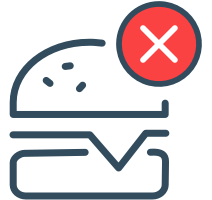
Avoid fatty foods like butter or cheese

Try eating bland foods like toast, crackers, or rice
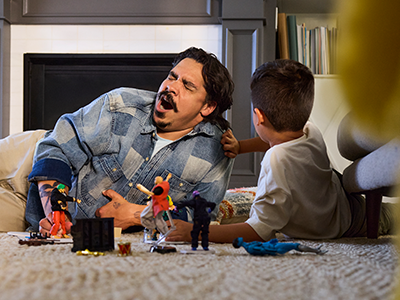
What is OSA and what are common symptoms?
Learn about the ins and outs of all things OSA.
Learn about OSA
